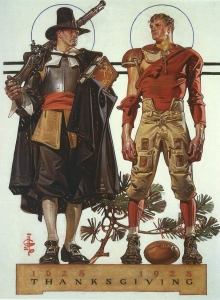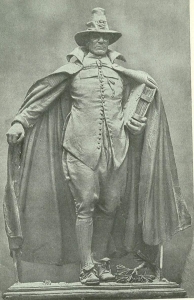
J. C. Leyendecker (1874-1951)|Pilgrim and Football Player, 1928|or, Thanksgiving 1628-1928 –300 years|Cover illustration for The Saturday Evening Post (November 24, 1928)|© 2008 Archives of the American Illustrators Gallery, NYC
J. C. Leyendecker sometimes referenced art by others in the construction of his illustrations, especially some of those he created for the covers of The Saturday Evening Post. While this fact is not remarkable in itself, what is note-worthy is that on a number of occasions Leyendecker used sculptural monuments by the late nineteenth-century American sculptor, Augustus Saint-Gaudens, as the inspiration for his work.
Early August 1907, the 59-year old sculptor Augustus Saint-Gaudens succumbed to cancer, after battling the disease for more than seven years. In the wake of his passing, the obituary articles and remembrances were justly effusive. Saint-Gaudens had changed the look of American sculpture making it reflective of contemporary life. Leyendecker’s first bit of appropriation from Saint-Gaudens’ work appeared a mere three months after the sculptor’s death, with the publication of that year’s Post Thanksgiving issue on November 23, 1907.

Augustus Saint-Gaudens (1848-1907)|Plaster model of The Deacon Samuel Chapin Monument, 1881-86|Springfield, Massachusetts
Leyendecker borrowed his image of the Puritan from the Saint-Gaudens’ public monument created for Springfield, Massachusetts. In 1881, the sculptor was commissioned to create a large-scale bronze monument to one of the early directors of the community, Deacon Samuel Chapin (1595–1675). Described as a forceful and dynamic man, he was said to be called, The Puritan, due to his exemplary life. The sculptor wrote in his Reminiscences that: “The statue . . . was to represent Deacon Samuel Chapin, but I developed it into an embodiment . . . of the ‘Puritan.'”* More than a likeness of a specific person, Saint-Gaudens transformed an abstract idea of The Puritan into a formal public monument. The figure is not intended as a specific portrait, but as a representation of Puritan tenets. Eyes focused downward, Saint-Gaudens’ figure strides determinedly forward with a knotty walking stick in his left hand across the pine-strewn New England wilderness, symbolized by a few scattered pine branches on the base.
Between 1907 and 1928 Leyendecker produced a variety of Thanksgiving-themed cover illustrations for the Saturday Evening Post that used Saint-Gaudens’ figure of The Puritan for their inspiration. For this 1928 Thanksgiving cover, Leyendecker juxtaposed The Puritan to the image of a contemporary young man wearing a tattered uniform having played football on Thanksgiving day. The linkage between the holiday and football was set in 1876 when the Intercollegiate Football Association initiated an annual Thanksgiving Day game between the previous year’s two leading college football teams.** In Leyendecker’s illustration the Puritan, from 300 years earlier, is dressed like Saint-Gaudens’ figure of the type, with one significant modification: he wears a metal breast-plate over his waistcoat, with his square-turned collar lifted over the armor.
Their clothing also echoes from one to the other, for example they both wear knee-pants and long stockings. The Puritan’s leather bound and locked bible is held in his left hand, with his cape wrapped arm and hand holding the book. In his right hand he holds the butt of a long rifle, with the stock leaning against his right shoulder. Linking the two cover figures together is a sprig of pine branch similar to that used on the base of Saint-Gaudens’ Puritan that seems to grow out of the base on which the pair stand. Most interesting is Leyendecker’s use of the same face and body-type for both characters, with their cleft chins, stern visages, and amazingly over-large hands.
One of the most interesting compositional elements defining and linking these characters illustrating life in America from the colonial and contemporary periods is the comparative use of protective armor. The Puritan’s armor is seen placed over his clothing and decoratively softened by the inclusion of a red waist sash and the square collar folded over the breast-plate’s neck edge. The football player’s armor–really neck and shoulder pads–is revealed by the happenstance of the player’s red jersey being torn at the shoulder and arm apparently during play. And if perchance you did not recognize the player’s uniform, Leyendecker helpfully painted a football between his feet.
Hope everyone enjoys their Thanksgiving–football and turkey!
* Homer Saint-Gaudens, ed., The Reminiscences of Augustus Saint-Gaudens: Volume I (London: Andrew Melrose, 1913): 354.
** James W. Baker, Thanksgiving: A Biography of an American Holiday (Durham, NH: University of New Hampshire Press, 2009): 75.
November 18, 2010
By Joyce K. Schiller, Curator, Rockwell Center for American Visual Studies
Norman Rockwell Museum






